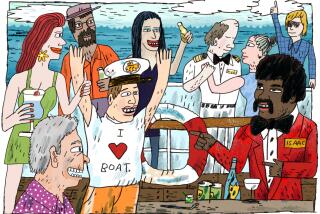Back to Nature in the Tropics
- Share via
PORT-OF-SPAIN, Trinidad and Tobago — Most visitors flock to Trinidad for Carnival (Feb. 24 to 27 this year). They jam the downtown streets and the grassy field of the Queen’s Park Savannah, which is Port-of-Spain’s Central Park, to listen to the throbbing melodies of steel bands and the racy rhymes of calypso singers. Above all they like the spectacle of the masqueraders, with costumes that each year become more elaborate or more risque. But of course there is more to this southernmost Caribbean island than the annual three-day bacchanal.
I confess, I might not have visited Trinidad were it not for my professional interest as an art historian, and that of John Van Sickle, my husband and a professor of comparative literature and classics, in two Trinidadian national treasures: Nobel laureate poet Derek Walcott and painter Donald “Jackie” Hinkson.
For the record:
12:00 a.m. Feb. 18, 2001 For the Record
Los Angeles Times Sunday February 18, 2001 Home Edition Travel Part L Page 6 Travel Desk 1 inches; 23 words Type of Material: Correction
In a Travel story about Trinidad Jan. 28 (“Back to Nature in the Tropics”), a photo caption misidentified the artist pictured; he is Dunstan St. Omer of St. Lucia.
Trinidad figures in a new epic poem written by Walcott and accompanied by his paintings (“Tiepolo’s Hound,” Farrar, Straus and Giroux); and we had written with admiration about a U.S. show of paintings by him and Hinkson.
We wanted to see something of the world--the people, places and atmosphere--that inspired Hinkson and Walcott. So, in a visit during Christmas week, we established our base camp in Port-of-Spain, where Hinkson lives. Walcott, a former resident and founder of the Trinidad Theater Workshop, which interprets local and world drama in a distinctively Caribbean style, was visiting too.
Port-of-Spain, which is the capital of this two-island nation, lies on Trinidad’s western side. Since the island was linked in prehistoric times to the coast of South America, seven miles away, it still harbors species closely resembling those in the Amazon rain forest. Columbus named the island, “Trinity” in Spanish, but Europeans didn’t give it much attention until the 17th century, when the French arrived, bringing African slaves and French customs such as the pre-Lenten Carnival. The island became British in 1802, and soon after, slavery was abolished. To work the rich cash crops, particularly sugar cane, the British brought in East Indians and, later, Chinese.
The melange of traditions and ethnicities is the subtext for much of Trinidad’s art, including Carnival. Being most interested in the visual arts, we began our visit at the National Museum and Art Gallery, on a street just off the south side of Queen’s Park Savannah. The gallery introduced us to the work of Trinidadians, which confirmed our impression that Hinkson is unique in his mastery of watercolor. His style reminded me of the technique of Edward Hopper, who recorded the vanishing architecture of American small towns much as Hinkson today captures a changing Trinidad.
Other parts of the museum helped place our little adventure in context. They charted the tectonic pressures that produced the green mountains framing Port-of-Spain, the oil deposits in the south that give Trinidad a unique economy among Caribbean islands, and Pitch Lake, an asphalt sump that is Trinidad’s own La Brea. Exhibits charted the fossils, flora and fauna, the Amerindians and the imported contributions to Trinidadian culture.
After the museum we admired the botanical garden and buildings that ring the Savannah, relics of colonial architecture that include former planters’ mansions, mainline churches and chic shops.
But village life and nature stand out in the works that inspired us to come. Walcott had told us not to miss seeing the ibises before sunset at the great Caroni Swamp. Hinkson had urged us to see a nature center up in the rain forest and a remote northern beach where sea turtles nest.
Access to Caroni is by boat, and limited, so we signed up for a late afternoon tour ($34 per person).
As the broad, flat-bottom boat chugged down a narrow channel canopied by mangroves, the guide called our attention to red crabs on the tangled roots and said that the diet of crabs gives the ibises their unique scarlet color, which soon fades in captivity. As our eyes got used to the shade, someone spotted a coiled tree boa digesting its last meal. Secretive little blue herons flitted ahead of us in the baffled light. From time to time we emerged from the mangrove corridors into lagoons where fish jumped at insects that luckily left us pretty much alone.
After one last mangrove tunnel, we tied up in a wide lagoon. Snowy egrets were clustering on the far side. New flocks came rushing by us, flashing their yellow feet.
“There’s one,” somebody said, and we looked up to see our first ibis, high above the mangroves, flashing scarlet in the rays of the late sun. It crossed the lagoon and vanished among the egrets. Then flotillas of ibis began coming, shooting out of the mangrove corridors, whirling over our heads in the sunlight. Their massed colors joined the egrets on the roost until it began to look like a great Christmas tree dotted with bright white and brilliant red.
Dusk is swift in the tropics. Our boatman steered us back through the maze in the dark, but the image of bright birds against the blue sky remained in our eyes.
After the seaside swamp, we turned next day to the mountain rain forest. Hiring a driver recommended by our hotel, we headed for the Asa Wright Nature Centre, which is in a valley of the Northern Range, the low green mountains that stretch from west to east across the island. Once the road leaves the coastal plain, it narrows and winds steeply up, down and around ravines through walls of ferns and bananas, with tall trees hugged by prolific philodendrons and ornamented by orchids and bromeliads.
We had telephoned ahead to reserve lunch. But we went first to the veranda to look out over the broad valley. The property had been a plantation, purchased in 1947 by amateur naturalists Richard and Asa Wright. After her husband died, Asa Wright donated the land with the provision that it remain a conservation preserve; botanists, ornithologists and ecologists study there now. Overnight guests are welcome when space permits.
Along the high veranda, feeders stocked with sugar water were attracting bright, noisy little birds-- honeyeaters, we were told by a lodger who was there for the week and had been using the library. Hummingbirds zoomed in and out, only a foot away. Below, fresh fruit spread on benches under mesh swarmed with several varieties of tanagers, an iridescent honeyeater and bulky oropendulas, elegant in yellow and black.
As amateur bird-watchers, we were mesmerized by the spectacle and had to be called away to lunch, an ample buffet of local specialties.
On the afternoon tour (only overnight guests may explore the network of hillside trails on their own), we passed a sign announcing “Bell-bird Trail.” We soon heard hoarse clanking sounds, rather like great bells. Soon the clanking was all around us, but peer as we might up into the canopy, we could see nothing. Someone gave a shout, and there, luminous in a ray of sunlight, was a white bird, rather modest in size to be making so much sound.
Another marker announced the lek (courtship space) of the white-bearded manakin. These little birds were quite natty and chatty, easy to see. The guide said the males compete for females by clearing a space on the ground; the male with the neatest space wins. That tidbit triggered a rash of significant glances in our group between husbands and wives.
Our third venture proved the most ambitious. It took us eastward along the mountains to the Atlantic coast villages where Hinkson often paints. Again we preferred hiring a driver (about $60, plus lunch for the driver), because traffic here goes on the left; the main road is congested; and the roads upcountry can be rough.
The shore road winds past jutting rocks and bursting ocean spume up to the northern coast. There it bends back westward between steep green slopes and quiet coves where sea turtles nest from March to August.
Our destination was the community of Grande Riviere and the rustic 12-room hotel, Mt. Plaisir, where we had reservations for lunch. The meal was served on plank tables in a dining area open to the beach, one of the few on this stretch of coast suitable for swimming. The day’s special was kingfish grilled with lime sauce--as fresh and tasty as one could wish.
We took a look at the guest rooms with the thought of a future stay. Each was decorated differently with murals and locally handcrafted furniture. The rooms have direct water views--the sound of the surf and seabirds was very present--but no window screens. Attractive mosquito nets hung above each bed. The staff was cordial and courteous, as were all the Trinidadians we met.
After lunch we walked down to the water and watched as pelicans fished. Combing the beach turned up crinkled shells from the sea turtle hatch (it occurs between May and September). With more time we could have hiked along the Grande Riviere an hour or so up to a great waterfall, and perhaps we would have seen another rare bird, the powi. I would have enjoyed time to read or sketch the views from the beach. At night the lodge lights great bonfires there. But our driver was waiting. The road does not travel well in the dark. We would have to come back for a stay.
(BEGIN TEXT OF INFOBOX / INFOGRAPHIC)
GUIDEBOOK
Indulging in Trinidad
Getting there: The only flights from L.A. that don’t require a change of airline are on American and Air Canada, with restricted round-trip fares beginning at $956.
Going country: Asa Wright Nature Center and Lodge: rooms (Dec. 16 to March 3) $120, double; for other rates and for tours, telephone (868) 667-4655, e-mail [email protected] or [email protected].
Trinidad & Tobago Sightseeing Tours: Caroni Swamp tour, $34 per person; Northeast Coast, $75. Tel. (868) 628-1051.
Where to stay (Rates are for December to March, excluding Carnival): Alicia’s House, 7 Coblentz Gardens, St. Ann’s. Rooms $35 to $40; tel. (868) 623-2802, fax (868) 623-8560.
Normandie, 10 Nook Ave., St. Ann’s. Doubles $85; tel. (868) 624-1181, e-mail [email protected].
Kapok Hotel, 16-18 Cotton Hill, St. Clair. Doubles $124 to $146; tel. (868) 622-5765, https://www.kapok.co.tt.
Mt. Plaisir, Grande Riviere, rents a beach loft that sleeps six for about $90 a night, suites for $80. Tel. (868) 670-8381, https://www.mtplaisir.com.
Where to eat: Solimar (our favorite), 6 Nook Ave., St. Ann’s; local tel. 624-6267. Artful cuisine, dinner about $40 each.
Tiki Village (in Kapok Hotel; see above). Upscale; big favorite with locals. Dinner runs about $40 per person. Tel. 622-6441.
For more information: Tourism and Industrial Development Co. of Trinidad and Tobago, P.O. Box 222, 10-14 Philipps St., Port-of-Spain, Trinidad, West Indies; tel. (868) 623-6022/3, fax (868) 624-8124, https://www.visitTNT.com.
More to Read
Sign up for The Wild
We’ll help you find the best places to hike, bike and run, as well as the perfect silent spots for meditation and yoga.
You may occasionally receive promotional content from the Los Angeles Times.





